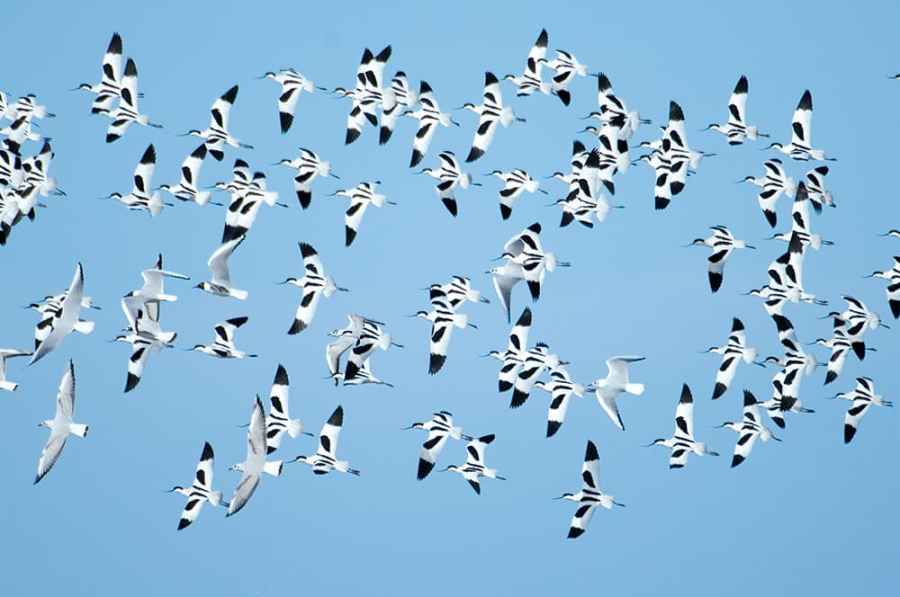
The avocet is a distinctive-looking bird, with its black-and-white plumage and curved bill
About the avocet
- Location In summer they can be found on coastal lagoons in the south and east of England, and the Exe estuary in winter.
- Size On average they are 42-45cm in length, with a wingspan of 77-80cm, and weigh about 140g.
- Nest This is a shallow scrape that sits on bare mud, made-up of short pieces or stems, roots and leaves.
- Diet The avocet’s diet is typically aquatic insects and their larvae, as well as crustaceans and worms.
- Population The UK is home to some 1,600 breeding pairs in the summer, with the population swelling in winter to some 7,500 birds.
With their piebald plumage and upturned bill, the avocet is one of Britain’s more striking and photogenic birds. In 1893 avocets became extinct in the UK due to land reclamation of their habitat. They returned during the 1940s and colonised coastal marshes that had been re-flooded as a defence against invasion by Germany. They have since increased and colonised many sites with an increasing breeding population of around 1,600 pairs.

Avocets breed on coastal marshes and lagoons
Habitat
Avocets breed on flat, open areas on the east and south coasts of England in summer. You can find them wading on mudflats, lagoons, beaches and estuaries.
Best time to shoot
Winter is the time to seek out flocks of avocets. When they take to the air they fly in tight formation and beautiful images can be created. With shots such as these, getting close is not necessarily desirable, so a telephoto zoom within the 80-500mm range is ideal.
By April, avocets are arriving at traditional breeding sites and there is a great deal of activity to photograph. Some might still be staying in tight flocks, while others start to pair up and establish a territory. By the end of the month, mating and territorial battles can provide the photographer with some interesting behavioural shots.

Avocets flying in close formation create some excellent photographic opportunities
Shooting advice
Never a dull moment
Once the chicks have hatched on wet or cool days, adults will frequently brood their young, calling the chicks over to huddle under their bodies. Intruding gulls, marsh harriers or other predators will be mobbed by adults. Photographing breeding avocets is never dull.
Getting close
Avocets breed on coastal marshes and lagoons along England’s south and east coasts. Large numbers are seen in winter in the southwest, with Poole Harbour in Dorset and the Exe Estuary in Devon being two hot spots.
The best sites for photographing avocets during the breeding season are from public hides on RSPB reserves – quite apt, as the avocet is the society’s distinctive logo. Their original stronghold of Minsmere in Suffolk (current home of the BBC’s Springwatch programme) offers close encounters and is my top spot for photographing them. Plus, this site offers lots of potential for getting great shots of many other species. Titchwell Marsh in Norfolk and a number of other smaller reserves are good, too. It’s also worth looking on the internet to see where avocets are being photographed, with www.birdguides.com a good resource.
Shooting tips
Avocet flocks in flight can be quite tightly packed when flushed by a bird of prey or other predator. When they wheel round, it is the patterning on the upper wing that makes for a very attractive image. Use as large a depth of field as possible to keep as many birds in the flock in sharp focus.
Avocets aggressively defend their territories, even against harmless ducklings. So if focused on a breeding bird, be ready if another bird approaches, as it is likely the avocet will chase it off.

RSPB reserves are great venues to spot adults and their chicks
Kit list
Beanbag
A beanbag is useful for resting your telephoto lens on when shooting from public hides.
Teleconverter
A teleconverter gives extra reach, and chances are you will always want to be that little bit closer.
David Tipling is one of the most widely published wildlife photographers in the world. His pictures appear on hundreds of book and magazine covers, and have been used in various other ways, from wine labels to being projected in New York’s Times Square. www.davidtipling.com








